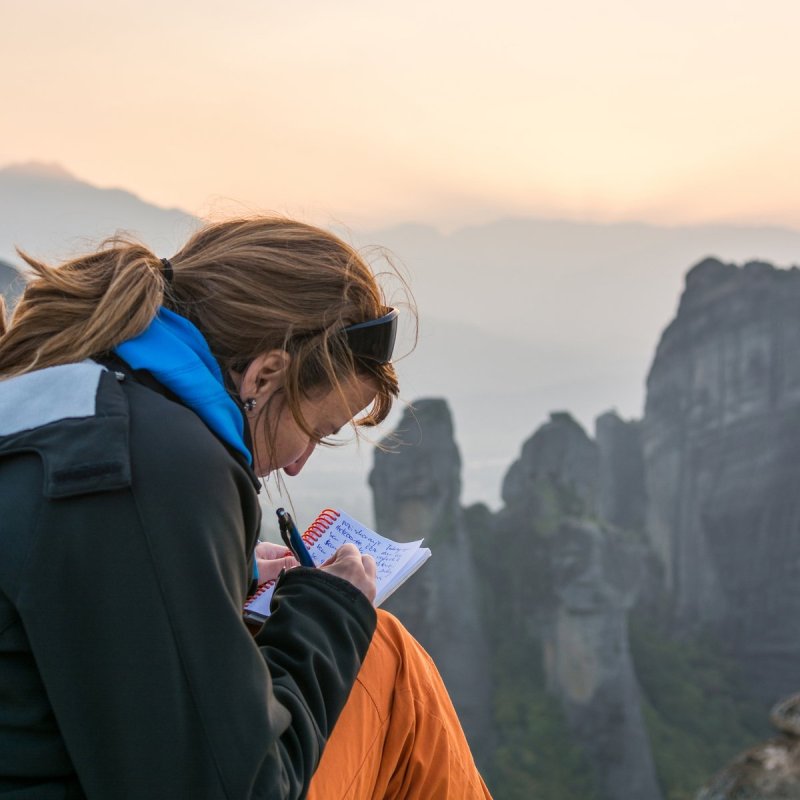
My sister gave me my first travel diary the year I turned 14, when my family took a trip to Italy. A small, yellow-lined notebook — I still have it in my box of childhood journals. I kept lists like “Souvenirs I Bought,” “Hotels We Stayed At,” “People I Met,” “Languages I Heard,” “Menus,” “Places Of Interest,” and “Anecdotes” (foreshadowing my future writer self!).
Videos by TravelAwaits
My 14-year-old self was onto something: Creating lists is a great way to capture the essence of a trip in your diary. Whether you’re going 10 miles away or to the other side of the world, a travel diary can enhance the journey and be a valuable keepsake. Here are suggestions for keeping a memorable one.

1. Pick Your Pen And Paper
Although I recognize in the digital age that many people “write” on an iPad or phone, I’m a big believer in the benefit of noting thoughts down the old-fashioned way, on paper, because the mind-body connection is more immediate. First, be sure you like the pen you select! Black felt-tip PaperMates have been my pen of choice for decades, and I’m very territorial. I don’t even like lending them to my husband!
I’m equally particular about my notebook. The wrong size or shape will never do. My requirements are that it’s 5” by 7”, its pages lie flat, it’s lined and hardback. If you’re traveling abroad, you might find it fun to shop for a journal wherever you’re visiting, because you’ll find a different selection of notebooks than you find in your home country.
My husband is British, so whenever we’re visiting my in-laws, I love picking up A5 notebooks in stationery shops. An evocative article in The New York Times by novelist Mary Gordon describes her pleasure in buying notebooks in France, Ireland, and Italy.
2. Choose When And Where To Write
You can start your diary before you even begin the trip, describing your plans and hopes, and continue it when you’re back home. When you’re embarking on a trip, you can describe your hopes, intentions, and fears; as you’re returning home, your memories, feelings, and next steps.
Different times offer different benefits: I’m a fan of Julia Cameron’s “Morning Pages” concept from her bestselling classic The Artist’s Way, where you scribble your wayward thoughts just after waking up. But you could also write late in the day, reflecting on your day’s explorations. And it always helps to record your impressions soon after you experience them, while they’re fresh.
As for where, certainly in your hotel room or rental apartment works. But it’s also fun sitting in a cafe, watching people while jotting notes down in your journal. One of my favorite memories is writing in a Seattle restaurant, where I spent several hours waiting for a late-night bus, eavesdropping on conversations I heard at the next table and scribbling snippets into my journal, making up stories about the other diners.
I love writing on airplanes, where sitting at 35,000 feet and looking at the clouds and the changing landscape below gives me a big-picture, expansive feeling.
What about trains? On a train in India, a man sitting to my right peered over my shoulder, started reading my journal, and proceeded to tell his friends what I had written — which luckily was not about them! Rather than offended, I burst out laughing. It made me realize how radically different boundaries are in different cultures. I couldn’t imagine someone openly reading my journal in the U.S.

3. Include The Day, Date, And Location
Your future self will thank you! In my early journals, I thought it looked hip thinking I was transcending time by skipping the date. Now, it’s a pain trying to find an entry back in the annals of my history.
4. Develop Your Observation Skills
A journal offers the opportunity to notice everything from architecture to wildlife. Focus on all your senses, then describe what you experience. Hearing, for example: When I’ve visited Muslim countries, I’ve been deeply moved by the haunting tones of the call to worship. Texture? The feeling of cobblestones under my shoes. Or taste — whether you’re describing a gumbo in New Orleans or a risotto in Sicily, putting down your impressions of a dish you savored will help to keep the memory alive.

5. Write About The People You Meet And See
Did you learn something new from a stranger? Were the local people welcoming? In my 1976 travel journal, I describe Ellen, the young woman from Michigan who I met in an Amsterdam hostel. She always wore a pink sweater and told me hair-raising stories about hitchhiking across Europe. A few years later, on the island of Crete, I met Ty from Alberta, and my travel journal from that era describes our walks to monasteries on dirt tracks lined with olive trees, and how she listened to me as I poured out my grief about the loss of my mother a year earlier.
6. Track What You Want To Change
While travel is often seen as a way to indulge, I’ve often found it easier and more natural to let go of unwanted habits when I’m away from home. I’ve quit smoking and stopped eating Doritos (the mainstay of my daily diet before I taught myself to cook!), both when on the road. One strategy that helps is to keep track of what you want to change, whether it’s exercising more, eating differently, handling conflict more productively, or spending less. As the management consultant Peter Drucker said, “You can’t improve what you don’t measure.”
7. Describe Your Moods
Emotions for most of us are more intense when away from home because we can’t depend on our usual anchors. This can be great — and not so great. Describe your highs and lows. Journals are a safe place to rant — better there than with your travel companions.

Louisa Rogers
8. Use Your Journal To Boost Your Creativity
On trips away from home, I’m often inspired to try different writing forms, like rhymed verse, haiku, and limericks. Many people sketch. If you don’t want to draw, you can still collect ticket stubs, museum passes, bus tickets, currency, and other local memorabilia and then create collages in your journal. All you need is a small pair of scissors and a glue stick. I’m not great at watercolor, but I often paint a streak down the side of a journal page for a burst of color.
9. Brainstorm On The Written Page
Being in a different environment often brings a fresh perspective on our lives back home. On a trip to Britain in 1976, I described in my journal the many charms I observed in the British way of life. Towards the end of our visit, while writing in my journal one day, I had an epiphany: I’d try to write an article for American readers who were unfamiliar with the public footpath system or (then low-cost) bed and breakfasts. On the flight home, I highlighted relevant passages from my journal. And indeed, a few months later, I sold the article to an airline magazine — and thus was a writing career born.
I’m not alone! Elizabeth Gilbert became the author of the best-selling 2007 memoir Eat, Pray, Love after her year traveling abroad following a traumatic divorce. Jeff Bezos, founder of Amazon, wrote a business plan on spare napkins while traveling across the U.S. And Howard Schultz, former chairman and CEO of Starbucks, hatched the idea of creating a coffee company while visiting Italy.
Travel diaries are just not about travel, they’re about life. As the classic American travel writer Paul Theroux said, “Travel is a state of mind. It has nothing to do with existence or the exotic. It is almost always an inner experience.”
No better way exists to discover and express that “inner experience” than through a travel diary. If you’re planning a trip, grab the moment and get started! Go find yourself the perfect notebook and pen for your taste, and start your journey.
Further Reading:
- How Writing About Travel Changed My Life And Can Change Yours
- 18 Great Summer Reads For Travel Lovers
